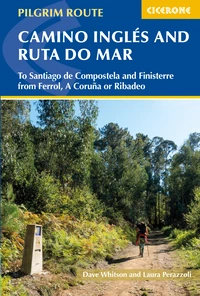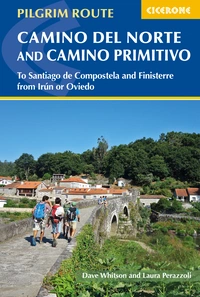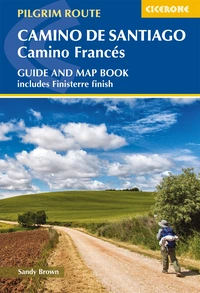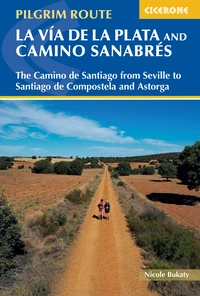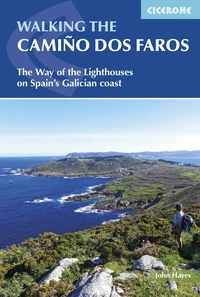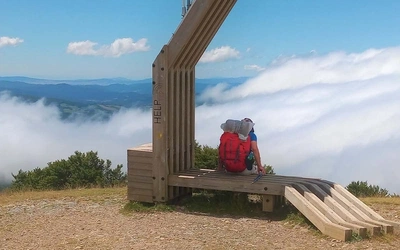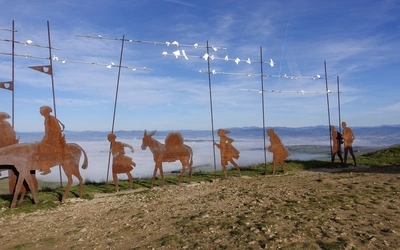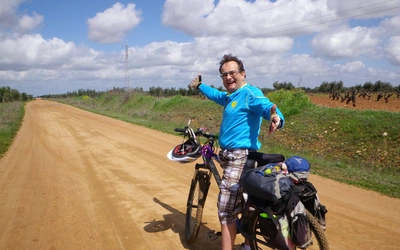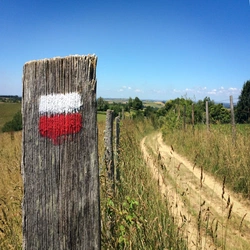Ruta do Mar: linking the Camino del Norte and Camino Inglés
Dave Whitson describes a pilgrimage route in northwestern Spain that offers a stunning coastal connection between the Camino del Norte and the Camino Inglés. Featuring soft, sandy beaches, dramatic cliffs, expansive solitude, traditional fishing villages and sacred shrines, this is a variant that leads through some of Galicia’s most memorable landscapes.
I suspect that any pilgrim who has trekked one of the northern variants of Spain’s Camino de Santiago has, at some point, stared at the map of Galician caminos and wondered: why isn’t there a route linking Ribadeo, the last coastal stop on the Camino del Norte, with Ferrol, the starting point of the Camino Inglés? Instead of cutting inland and rejoining the more-famous Camino Francés for the final approach to Santiago, a coastal approach would keep pilgrims well off the beaten path, all the way through to the Praza do Obradoiro in Compostela.
Well, my friends, allow me to introduce you to the Ruta do Mar. Also known as the Camiño do Mar, this pilgrim road to Santiago offers a coastal link between the Camino del Norte and Camino Inglés. While it lacks the same kind of pilgrim infrastructure that its neighbouring routes enjoy, its historical bonafides are clear and its spectacular coastal scenery is almost unparalleled. This is an opportunity to be a trailblazing pilgrim, away from the crowds.
The Camino Ingles and Ruta do Mar
To Santiago de Compostela and Finisterre from Ferrol, A Coruna or Ribadeo
£14.95
Guidebook to walking the Camino Inglés and Ruta do Mar pilgrim routes in northwest Spain. Describes the 116km Camino Inglés from Ferrol or A Coruña to Santiago de Compostela and the of the 190km Ruta do Mar linking Ribadeo with the Inglés at Ferrol. Includes the 120km Camino Finisterre from Santiago to Finisterre or Muxia.
More informationChoosing your camino
The Camino Inglés is an ideal ‘starter camino,’ particularly for those who have time constraints or concerns about committing to a longer trek. The terrain is gentle enough to be manageable for all walkers (although certainly not flat!), stages can be kept relatively short, and there are some distinctly Galician towns to stay in offering lively experiences.
By contrast, the Ruta do Mar is best pursued, for now at least, by experienced walkers who can manage with far less reliable waymarking and more erratic facilities. Lacking albergues, it’s a more expensive walk, and it can be a lonely experience. That said, it can also be a genuinely exciting process, being at the forefront of the recovery of a historic pilgrimage route.
The most exciting part about the Mar’s addition to the camino network is the potential to combine it with other routes. Pilgrims on the Camino del Norte, in particular, may be intrigued by the possibility of following the coast all the way to Ferrol, and then walking the Inglés into Santiago, avoiding the Camino Francés completely. This is a much longer walk, just over 300km if following our recommended approach, and exceeding the Norte/Francés combination by roughly 100km. However, it makes the pilgrimage a genuinely coastal experience nearly all the way to Santiago.
Thanks to the enterprising work of Spanish historians over the past couple of decades, including Xoán Ramón Fernández Pacios with the Centro Interpretación e Información do Camiño Norte in Mondoñedo, we are now able to reconstruct the historical routes followed by many past pilgrims in this lovely part of Galicia.
While it certainly never attracted the numbers of the Camino Francés, or even the Norte, it was known and followed by an international collection of pilgrims for at least five centuries.
The most notable historic site on the Mar is located some 30km from Ribadeo. The Basilica of San Martiño de Mondoñedo, located near Foz, is believed to be the oldest cathedral in Spain, consecrated in 925, although preceded by another basilica several centuries earlier. It’s a remarkable structure, containing wonderfully well-preserved 12th century murals and a series of Romanesque capitals. A pilgrim hospital is documented here in 1531, but it clearly had been in operation for a while at that point. A neighbour noted in 1704 that many ‘sick and troubled’ people seeking Santiago’s intervention passed by the basilica.
Outstanding records
While some pilgrims would turn inland from the basilica, following a route recovered today (the Camiño Natural de San Rosendo) that leads to Lourenzá on the Camino del Norte, many others would continue near the coast towards the bridge in Fazouro. From here to Viveiro, the route is not as well documented, but pilgrim hospitals are documented in Lieiro (near today’s San Cibrao) and Celeiro. The latter, the Hospital de Santa Ana, survives in the form of its extant chapel. Fernández Pacios has unearthed some outstanding records for this lodging, including an inventory from 1613 that logs the hospital’s supplies, which included five feather beds, three wool mattresses, 26 sheets (nine new, everything else old), two copper pots and one wood chair.
Viveiro was a major stop on the Ruta do Mar, with as many as six pilgrim hospitals at its peak. Some ships would stop here, although many other pilgrims arrived by land. From here, they proceeded in several different directions. Most researchers have concluded that the most popular approach was inland towards Vilalba, with pilgrims joining the Norte. Others veered towards Lugo and the Camino Primitivo. However, evidence from the 16th and 17th centuries confirms a third coastal option towards Ortigueira, ultimately merging with the pilgrim road to San Andrés de Teixido and then the Camino Inglés in Ferrol.
San Andrés Teixido is the bookend to San Martiño de Mondoñedo – the second destination on the Mar of great spiritual significance. The legend goes that Saint Andrew, brother of Peter, was stranded here after his boat capsized and subsequently took residence. Jealous of being overshadowed by Santiago de Compostela’s greater appeal to pilgrims, Andrew ultimately won a concession from Peter and God that guaranteed all mortals would eventually come to his shrine as well.
One strand of this legend holds that those mortals who failed to visit Teixido while living would be reincarnated as lizards, toads and snakes to make the trip. Come now to save yourself the trouble later!
The academic work completed by researchers has been complemented by the boots-on-the-ground efforts of the Amigos del Camino de Lugo, who helped to mark the Ruta do Mar with the famous yellow arrows. It’s a valuable, if highly inconsistent and unreliable, starting point. The Mar is paralleled between Ribadeo and Ortigueira with a modern sightseeing route, the Camiño Natural da Ruta do Cantábrico, which generally holds tightly to the coastline and enjoys far more reliable signage. The last section of the Mar, linking Teixido and Xubia/Narón (near Ferrol, on the Inglés), enjoys the red and white arrows associated with the Teixido pilgrimage.
Official recognition
Much work needs to be done to bring the Mar on par with its pilgrimage peers. For one, it lacks official recognition as a pilgrim road, although the historical evidence unearthed makes for a compelling case. Second, it lacks any sort of pilgrim infrastructure, with no pilgrim albergues to offer inexpensive accommodation. And, as noted, the waymarking is spotty and largely necessitates GPS support.
However, it also offers an experience that many of today’s pilgrims crave, as more popular and established caminos become ever-more crowded, combining pristine solitude, stunning natural splendor, sacred shrines and traditional fishing villages. It is also highly customisable, allowing for a direct link between Ribadeo and Xubia/Narón that runs less than 200km, or a more scenic jaunt along the Galician coastline that pushes 300. Regardless of the approach followed, it offers a distinctly authentic Galician experience that offers some of the finest views of any camino.


